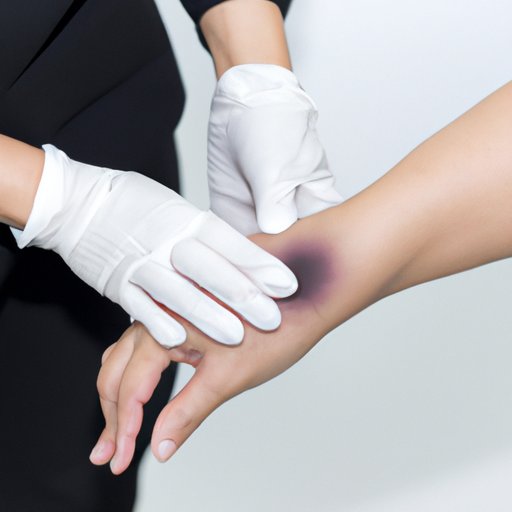Introduction
Ringworm is a fungal infection that can affect anyone who comes in contact with it. It is highly contagious and can cause skin irritation, itching, and redness. While it is not a life-threatening condition, it can be uncomfortable and lead to further infections if left untreated. This article provides a comprehensive guide to help readers understand the various aspects of ringworm, including symptoms, treatment, prevention, and common mistakes to avoid.
Understanding Ringworm: Symptoms, Causes and Treatment Options
Ringworm is a fungal infection that affects the skin, hair, and nails. It is caused by a type of fungus called dermatophytes and is highly contagious. It can spread from person to person by sharing infected items, skin-to-skin contact, and even contact with contaminated surfaces.
The common symptoms of ringworm include a red, scaly rash with raised edges that gradually spreads. It may appear as a circular or oval-shaped patch on the skin. Other symptoms include itching, burning, and skin peeling. It can affect different parts of the body, including the scalp, feet, groin, nails, and beard area.
Ringworm infections are caused by fungal spores that grow on the skin’s surface. The spores can survive on surfaces for several weeks and can be difficult to eradicate. In addition to poor hygiene, other risk factors for ringworm infections include weakened immune systems, living in close quarters, and exposure to infected animals.
Several treatment options are available for ringworm infections. Antifungal medications such as creams, ointments, sprays, and shampoos may be used to treat the infection. In severe cases, oral medications may also be prescribed. It is important to continue the treatment for the recommended period, even if the symptoms disappear after a few days.
The Ultimate Guide to Treating Ringworm with Over-the-Counter Medications
There are several over-the-counter products available to treat ringworm infections. These include topical creams, sprays, and powders that contain antifungal agents such as miconazole, terbinafine, and clotrimazole. While these products are usually effective in treating mild to moderate infections, it is important to choose the right one based on the area of the body affected.
When selecting an over-the-counter product to treat ringworm, it is essential to read and follow the instructions carefully. Topical treatments should be applied directly to the affected area for the recommended period to achieve optimal results. If the symptoms do not improve within a week or two, it is important to seek medical attention.
5 Natural Remedies for Curing Ringworm at Home
In addition to over-the-counter medications, several natural remedies may also help in treating ringworm infections. These include:
- Tea tree oil
- Apple cider vinegar
- Aloe vera
- Garlic
- Coconut oil
These products contain antifungal and antibacterial properties that can help kill the ringworm fungus. However, it is important to use these natural remedies with caution and under medical supervision. They may not be effective in severe cases and may cause skin irritation or allergies in some individuals.
Combating Ringworm: Common Mistakes to Avoid When Treating the Infection
When treating ringworm infections, there are several common mistakes to avoid. These include:
- Sharing personal items such as towels, combs, and clothing
- Ignoring the symptoms and hoping they will disappear on their own
- Stopping the treatment as soon as the symptoms improve
- Using multiple products at the same time
- Skipping or forgetting to apply the medication
These mistakes can lead to further infections and may worsen the symptoms. It is important to take ringworm infections seriously and seek medical attention if necessary.
Effective Ways to Prevent Ringworm From Spreading
Preventing ringworm infections is crucial to avoid spreading the fungus to others and reinfecting yourself. Here are some effective ways to prevent ringworm:
- Practice good hygiene, including washing hands regularly and keeping skin clean and dry
- Avoid sharing personal items such as towels, clothing, and combs
- Clean and disinfect surfaces regularly
- Avoid contact with infected animals or people
- Wear protective clothing such as gloves and shoes in public areas
Step-by-Step Process to Getting Rid of Ringworm for Good
While ringworm infections can be uncomfortable and persistent, they can be treated effectively with proper care and attention. Here is a step-by-step guide to getting rid of ringworm:
- Identify the symptoms and seek medical attention if necessary
- Follow the prescribed treatment course and apply the medication as directed
- Clean and disinfect personal items and surfaces
- Avoid contact with infected individuals or animals
- Practice good hygiene and maintain skin health
By following these steps and taking adequate precautions, it is possible to get rid of ringworm for good.
Conclusion
Ringworm infections can be uncomfortable and persistent, but they can be treated effectively with proper care and attention. It is important to seek medical attention if the symptoms persist or worsen despite treatment. Good hygiene practices and taking adequate precautions can help prevent ringworm infections and avoid spreading the fungus to others. Remember to choose the right treatment and follow the recommended course to get rid of ringworm for good.
